Scotland's Wellbeing: national outcomes for disabled people
Analysis of the National Performance Framework (NPF) outcome indicators from the perspective of disability.
6. Education
We are well educated, skilled and able to contibute to society
What we Know:
- Disabled people (25%) are more likely than non-disabled people (10%) to have low or no qualifications at SCQF level 4.
- The vast majority of disabled school leavers are recorded as leaving to a positive destination (89%) although this remains lower than for non-disabled school leavers (95%).
- Comparable proportions of disabled and non-disabled people have received in-work training in the last three months.
- A lower proportion of disabled people leave school for higher education or have university degrees, compared to non-disabled people.
- The proportion of those commencing Modern Apprenticeships who are disabled has increased since 2016/17.
- The number of disabled students attending Scottish Higher Education providers has increased since 2013/14, from 9% to 12% of the total.
National outcome
This outcome aims towards having an education system which encourages participation, inspiring everyone to reach their potential. It recognises that the desire to learn continues throughout life and values teachers, educators and academics to aspire to the highest standards across learning and research. It also recognises work with partners in business, industry, science and academia to ensure that Scotland has the talents and abilities to flourish in future.
National Performance Indicators
At present, there are nine indicators for Education. Of these, four do not yet have defined measurements:
- Educational attainment – no agreed indicator
- Confidence of children and young people – no agreed indicator
- Resilience of children and young people – no agreed indicator
- Engagement in extra-curricular activities – no agreed indicator
Of the five remaining indicators, two of these are not individual level measurements and therefore are not amenable to individual level analysis:
- Skill shortage vacancies (Proportion of establishments reporting at least one skills shortage vacancy).
- Skills underutilisation (Proportion of establishments with at least one employee with skills and qualifications more advanced than required for their current job role).
The three remaining indicators can be analysed at an individual level and are available with a demographic breakdown that includes disability:
- Work place learning (Percentage of employees who received on the job training in the last three months).
- Young people’s participation (Percentage of young adults (16-19 year olds) participating in education, training or employment).
- Skill profile of the population (Proportion of adults aged 16-64 with low or no qualifications at SCQF level 4 or below).
Work Place Learning
In 2018, there was little difference in the proportion (22.6%) of non-disabled people in Scotland reporting receiving job related training in the past three months than disabled people (22.4%).[29]
Young People’s Participation
This indicator measures the number of people aged 16-19 who are not in education, employment or training (NEET). This is calculated using the Annual Participation Measure for 16-19 year olds, published by Skills Development Scotland (SDS).[30] In 2018, this reported that that 86% of disabled young people were in education, employment and training, compared to 92% of non-disabled young people (see Figure 6.1).
Figure 6.1 Participation in employment, education or training, by disability. From Annual Participation Measure for 16-19 year olds, 2016-2018.
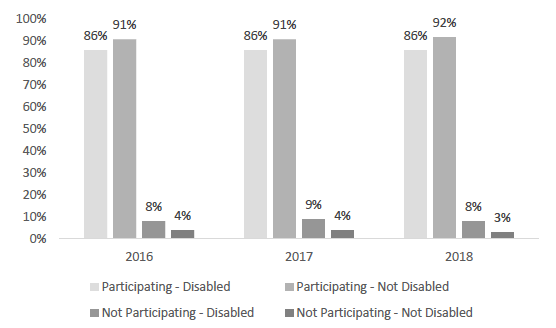
Source: Skills Development Scotland 2018
The proportion of those studying modern apprenticeships who are disabled people has increased in recent years. In 2018/19, this was 14% of participants, compared to 9% in 2016/17 (when the disability disclosure monitoring question was introduced).[31]
Skill profile
Data from the Annual Population Survey (APS) indicates that, in 2018, around 25% of disabled people (aged 16-64) had no qualifications at SCQF level 4 or below, compared to 10% of non-disabled people (see Figure 6.2).
Figure 6.2 Proportion of adults aged 16-64 with low or no qualifications at SCQF level 4 or below, 2004-2018, by disability. Grey area indicates missing data.
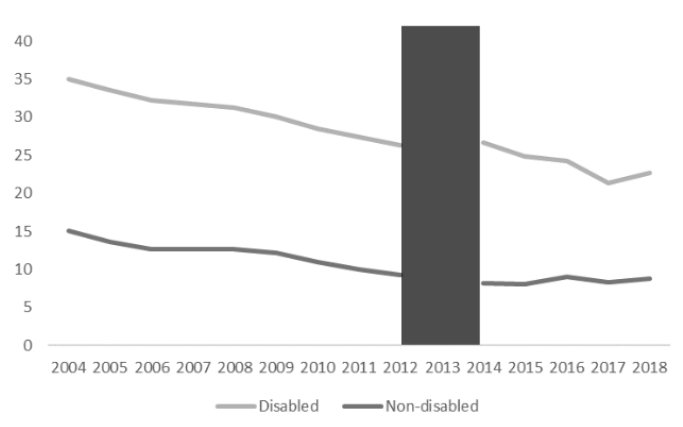
Source Annual Population Survey (Jan-Dec), Office for National Statistics 2018
Additional Indicators
Highest Qualifications
In the UK as a whole, the Labour Force Survey (LFS) found that, in 2017, 19% of disabled people have a degree or equivalent, compared to 32% of non-disabled people (see Figure 6.3).[32]
Figure 6.3 Highest Qualification, by disability.
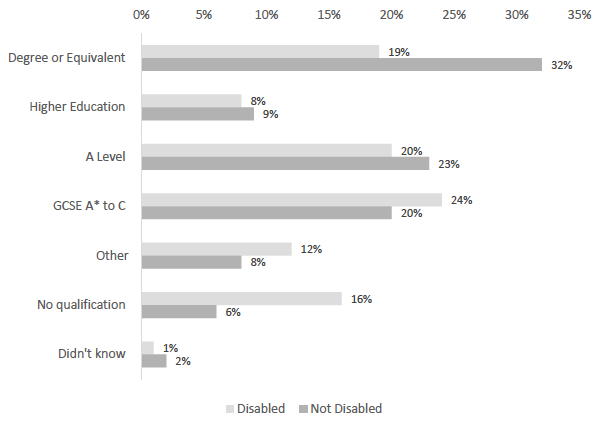
Source: Labour Force Survey 2018
School Leaver Destinations
When the outcomes for school leavers from publicly funded secondary schools are measured, 89% of those assessed as or declared disabled school leavers in 2017/18 go on to positive destinations.[33] This is lower than the 95% of non-disabled school leavers.
Figure 6.4 Destinations of those leaving school from publicly funded secondary schools with positive destinations, 2017/18 by whether a disability was declared or assessed.
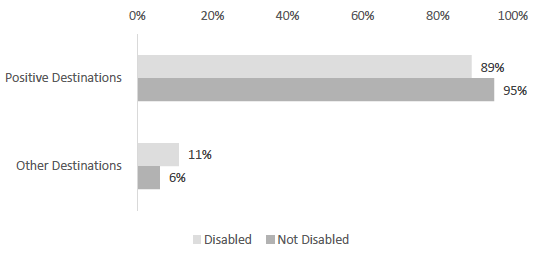
Source: Summary Statistics for Attainment and Initial Leaver Destinations, 2019
As shown in Figure 6.5, the number of non-disabled students leaving for higher education is roughly double the number of disabled students. However, the proportion of those leaving for further education is substantially higher among disabled people relative to non-disabled people.
Figure 6.5 Percentage of Students leaving for Different Positive Destinations, by disability, in 2017/18.
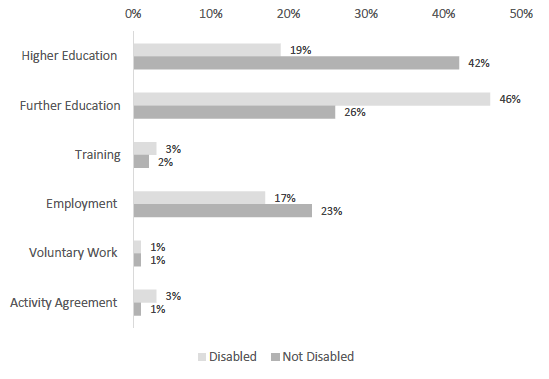
Source: Summary Statistics for Attainment and Initial Leaver Destinations, 2019
At Scottish Higher Education providers, participation in Higher Education by disabled people increased from 2013/14 to 2017/18. The numbers increased from 21,475 disabled students in 2013/14 to 30,500 disabled students in 2017/18 (see Figure 6.6). The overall percentage of disabled students in the student body has increased from 9% in 2013/14 to 12% in 2017/18.[34]
Figure 6.6 Students at Scottish Higher Education providers, by disability, per year.
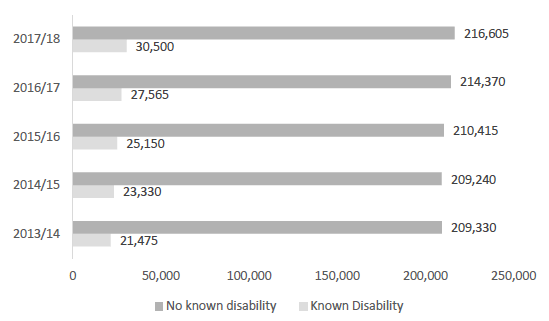
Source: Higher Education Statistics Authority data from 2013/14 to 2017/18
Contact
Email: joseph.ritchie@gov.scot
There is a problem
Thanks for your feedback